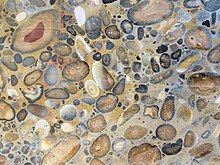Pudinga
Aparencia

As pudingas son un tipo de conglomerado formado por croios caracteristicamente redondeados cuxa cor adoita contrastar coa matriz de gran fino que os rodea, xeralmente areosa, e co cemento. Os croios redondeados de cor contrastada dánlle a este tipo de conglomerados a aparencia de uvas ou pudin.[1][2] Hai diferentes tipos de pudingas, con diferenzas en composición, orixe e distribución xeográfica. Exemplos de pudingas de diferentes tipos son as pudingas de Hertfordshire, Schunemunk, Roxbury e illa de St. Joseph (illa Drummond).
Notas
[editar | editar a fonte]- ↑ Neuendorf, K.E.K., J.P. Mehl, Jr., and J.A. Jackson (2005) Glossary of Geology. Springer-Verlag, Nova York, 779 pp., ISBN 3-540-27951-2
- ↑ The McGraw-Hill Companies (2003) McGraw-Hill dictionary of geology and mineralogy, 2nd ed. The McGraw-Hill Companies, Inc, New York, 420 pp., ISBN 0-07-141044-9
Véxase tamén
[editar | editar a fonte]Ligazóns externas
[editar | editar a fonte]- Anónimo (nd) Hertfordshire Puddingstone., East Herts Rock Club, Ware, Inglaterra.
- Kelley, J.G., (2009) Drummond Island Puddingstone. Arquivado 24 de agosto de 2013 en Wayback Machine. Drummond Island Tourism Association, Drummond Island, Míchigan.
- Share, J. (2011a) Architectural Geology of Boston: The Roxbury Conglomerate (Puddingstone) Part I – The Tectonic Evolution and Journey of Avalonia. Written In Stone...seen through my lens.
- Share, J. (2011a) Architectural Geology of Boston: The Roxbury Conglomerate (Puddingstone) Part II - Quarries and Building Stone. Written In Stone...seen through my lens.
- Tubb, J. (2009) Ancient Quarrying of Rare in situ Palaeogene Hertfordshire Puddingstone (Lovell and Tubb Mercian Geologist August 2006). An update. East Herts Rock Club, Ware, Inglatera.
